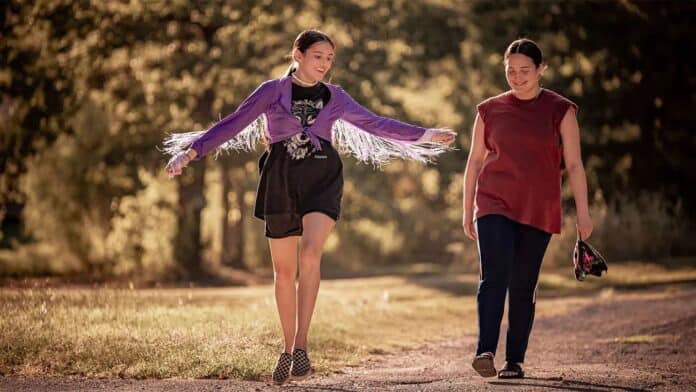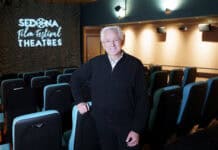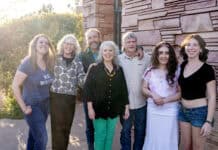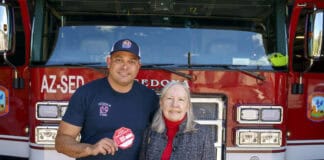
The Verde Valley Archaeology Center will be hosting its Indigenous Film Festival in partnership with the Sedona International Film Festival on Friday, Nov. 3, and Saturday, Nov. 4.
The two-day event will feature films from the United States, Canada and Latin America.
“As a museum, we have to honor all aspects of the art world,” VVAC executive director Monica Buckle said. “Film and cinema are such an integral part of the arts, especially Native American and indigenous cinema. There’s been so much going on across Indian country with film and cinema, so it felt like the natural course to integrate that into a fun event for the museum.”
The feature film for Friday evening will be “Voices Across the Water,” which follows the lives of two men who practice the vanishing art of creating traditional First Nation canoes.
Friday’s opening reception will also include a blessing song from Ted Pavatea and performances by the Madthii Swaddi Boys, a group of traditional bird singers and dancers, and the Warriorettes, a Yavapai-Apache Nation youth dance group. The reception also functions as a fundraising benefit for VVAC, which is in need of funding to keep the nonprofit organization running.
“Aitamaako’tamisskapi Natosi: Before the Sun” will be the featured documentary for Saturday evening. This film follows the life of Logan Red Crow, a Siksika woman whose passion is the Indian relay race, in which riders vault bareback from horse to horse in thrilling, quick-paced short races.
Short films will be screened prior to each evening’s feature. A full list of films can be found on VVAC’s website.
The festival expands upon the storyteller cinemas that the center’s director emeritus, Ken Zoll, would hold at VVAC. Buckle reached out to Patrick Schweiss, executive director of the Sedona International Film Festival, about partnering for the event.
“We’re so grateful that he’s affording us the space at the Mary D. Fisher Theatre, and for helping us to make this a great event for us, not only as a fundraiser but also for the regional tribes that are involved as well,” Buckle said. “What better way to learn more about Native American culture than directly through their lens.”
The festival aims to create cultural understanding as a way of breaking down systematic barriers. “Our vision for the future of cinema is one in which Native American and indigenous perspectives are respectfully pictured, recognized and valued in a way that promotes authentic identities, economic outcomes, equity and wellbeing for our indigenous communities,” the festival’s press release stated.
The films will be screened at the Mary D. Fisher Theatre at 2030 W. State Route 89A in Sedona. For more information, visit verdevalleyarchaeology.org/indigenousfilmfestival.
Friday, Nov. 3, 5 p.m. at the Mary D. Fisher Theater, Sedona.
5 p.m. Catered reception
6 p.m. – Ted Pavatea, a Hopi and Tewa, is a traditional drummer, singer and renowned artist. He will sing a blessing song on his drum. The Madthii Swaddi Boys and Salty Earth Singers, traditional bird singers and dancers from an intertribal group of the Yavapai-Apache Nation, led by Ronald Juan, a Quechan of Yuma, and Marley Juan, from the Yavapai-Apache Nation. They will be followed by the Warriorettes, a Yavapai-Apache Nation youth dance group, led by Reba Franco, from the Yavapai-Apache Nation.
6:30 p.m. “Voices Across the Water”: Alaskan Tlingit Wayne Price and Yukon francophone Halin de Repentigny are among the last canoe builders. At a glance, these two men lead very different lives but they are connected as practitioners of the disappearing art of traditional canoe construction. Both are also visual artists of significant repute, with their life’s work rooted in the landscapes of their distinct cultures. Each is 60 years old reflecting on a life rich in experience and accomplishment, an age when people also think about legacy and succession.
But does anyone care anymore about these disappearing art forms? Who will carry on making birch bark and dugout canoes? What happens to hundreds or thousands of years of knowledge when they are gone?
Saturday, Nov. 4, 1:30 p.m. at the Mary D. Fisher Theater, Sedona.
“Burros”: From executive producer Eva Longoria, the award-winning Burros was shot on location at the Tohono O’odham Nation. In southern Arizona, 20 miles from the Mexico border, a young Tohono O’odham girl discovers a Latina migrant her age who has been separated from her father while traveling through the Nation into the United States. Among the awards are:
- Best Narrative Short – Santa Fe International Film Festival;
- Best Dramatic Short – Arizona International Film Festival
- Best in Show – Savannah Film Festival
- Best Narrative Short – Anchorage International Film Festival
- Best Live Action Short – Red Nation Film Festival
“Fancy Dance”: A drama film directed by Erica Tremblay, in her feature directorial debut from, a screenplay by Tremblay and Miciana Alise. It premiered at the 2023 Sundance Film Festival on Jan. 20, 2023. Since her sister’s disappearance, Jax (Lily Gladstone) has cared for her niece Roki (Isabel Deroy-Olson) by scraping by on the Seneca-Cayuga Reservation in Oklahoma. Every spare minute goes into finding her missing sister while also helping Roki prepare for an upcoming powwow. At the risk of losing custody to Jax’s father, the pair hit the road and scour the backcountry to track down Roki’s mother in time for the powwow.
Saturday, Nov. 4, 1:30 p.m. at the Mary D. Fisher Theater, Sedona
“Sousa on the Rez: Marching to the Beat of a Different Drum”: The film profiles two contemporary Indian community bands: the Iroquois Indian Band from upstate New York and the Fort Mojave Tribal Band based in Needles, Calif.

The documentary short traces the origins of these groups from their founding over 100 years ago and uncovers a secret history of the 20th century when “All Indian Bands” toured the U.S. and abroad in the 1800s and 1900s, when dozens of Indian bands existed. Many Indian boarding schools had their own bands, including the band at the Carlisle Industrial School in Pennsylvania. School bands were not the only Native groups performing marches and parade music; many tribal communities organized their own community bands that performed for both Native and non-Native audiences. Professional ensembles toured nationally and abroad, providing employment opportunities for musicians in a time when opportunities for Native people were limited. As marching band music became less popular, however, many of these groups disbanded. Today, four multi-generational community-based tribal bands remain in the US, carrying on the rich tradition of Sousa in their communities. In addition to the Iroquois Indian and Fort Mojave bands, the Navajo Nation and Zuni Pueblo host vibrant bands.
“A Love Song”: Faye (Dale Dickey) is a lone traveler biding her time fishing, birding and stargazing at a rural Colorado campground as she awaits the arrival of Lito (Academy Award-winner Wes Studi), a figure from her past who is navigating his own tentative and nomadic journey across the rugged West. Like the country music that has traditionally channeled the heartbreak and resilience of Americans in search of themselves and others, A Love Song weaves a lyrical and ultimately joyful refrain out of the transformative act of being alone נand reminds us that love can nourish and mystify at any age.
Saturday, Nov. 4, 7 p.m. at the Mary D. Fisher Theater, Sedona
“Long Line of Ladies”: From Academy Award-winner Rayka Zehtabchi and Shaandiin Tome, this short documentary tells the story of a girl and her community as they prepare for her Ihuk, the once-dormant coming of age ceremony of the Karuk tribe of northern California. The Ihuk Ceremony brings together the young girl’s family and community to make luck and medicine for her as she transitions into becoming a young woman. This is one of the few ceremonies when an entire family can dance and sing together.
“Aitamaako’tamisskapi Natosi: Before the Sun”: This documentary has won Best Feature Documentary, Best Sound, Best Cinematography, Best Editing and Best Scriptwriting, that takes us to the golden plains of the Blackfoot Nation of southern Alberta, to the home of Logan Red Crow, a young Siksika woman whose passion is the Indian Relay.
A sport for the truly brave, the Relay’s bareback riders vault from horse to horse in short, exhilarating races. The film offers the dual pleasures of serenity and suspense with leisurely, lyrical immersion in rural life as well as the thrill of rooting for victory. Logan’s bond with her horses is palpable. The animals are beautiful in their mute strength, and the director honors them with loving, graceful images.


















